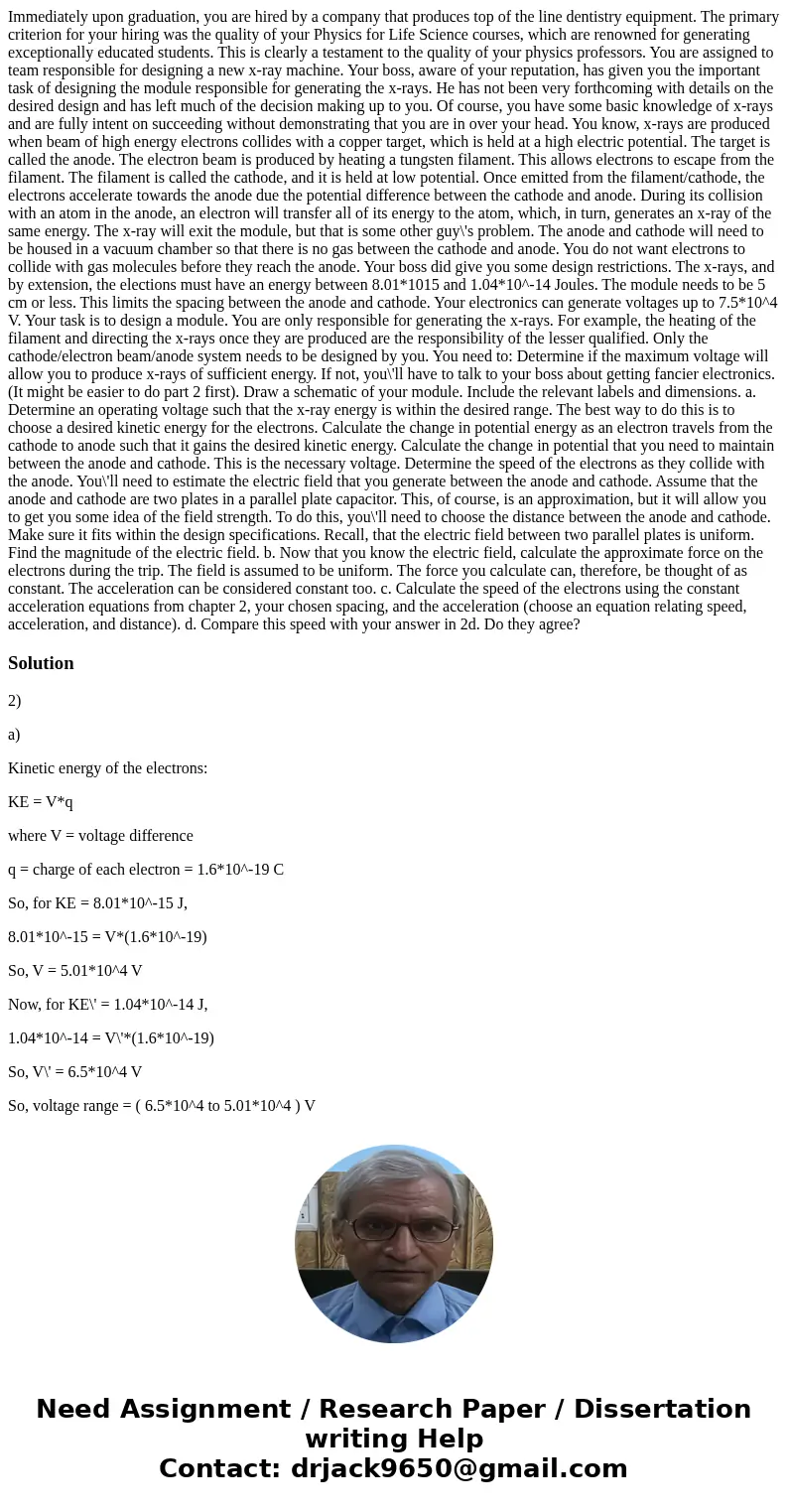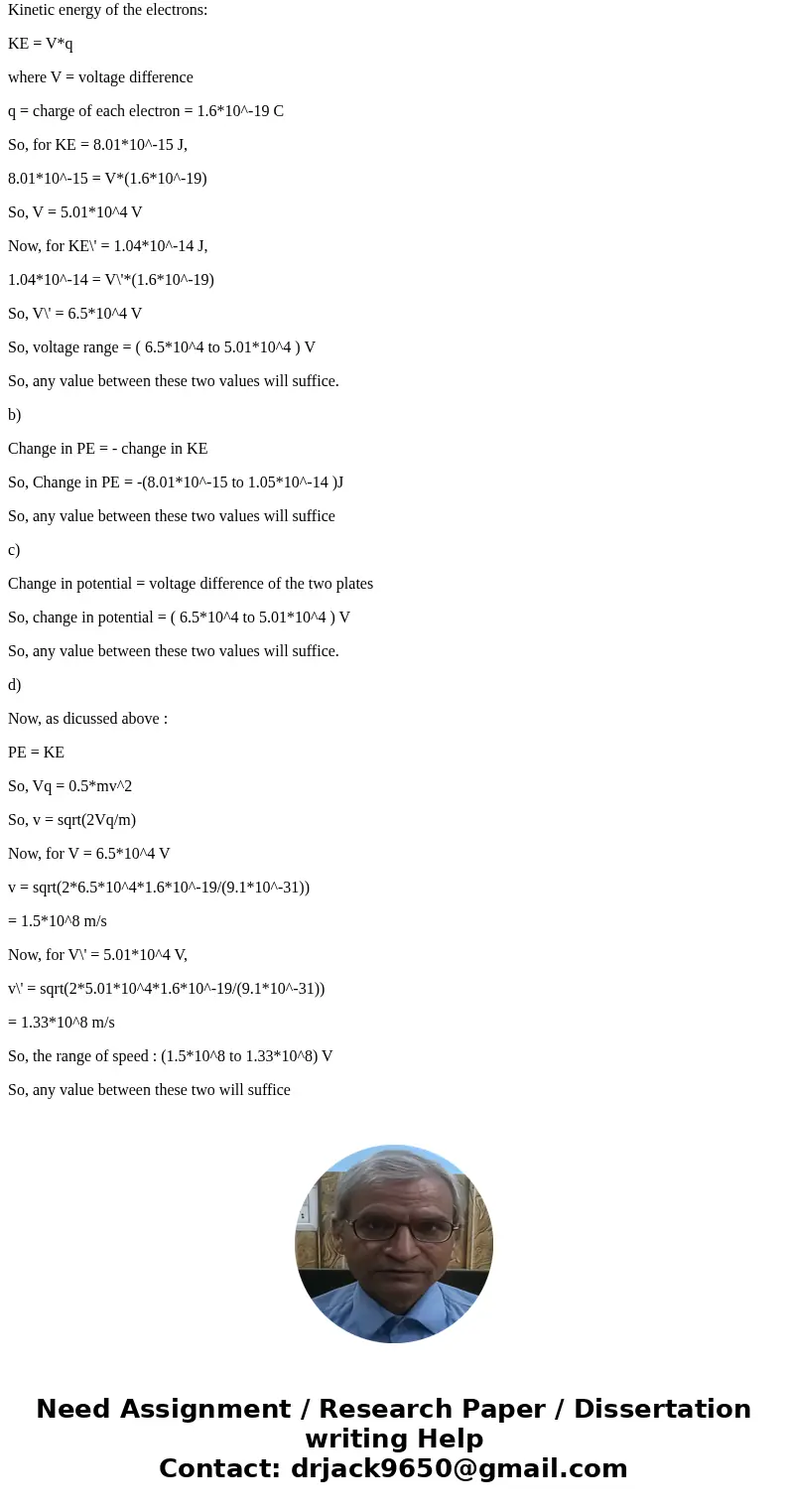Immediately upon graduation, you are hired by a company that produces top of the line dentistry equipment. The primary criterion for your hiring was the quality of your Physics for Life Science courses, which are renowned for generating exceptionally educated students. This is clearly a testament to the quality of your physics professors. You are assigned to team responsible for designing a new x-ray machine. Your boss, aware of your reputation, has given you the important task of designing the module responsible for generating the x-rays. He has not been very forthcoming with details on the desired design and has left much of the decision making up to you. Of course, you have some basic knowledge of x-rays and are fully intent on succeeding without demonstrating that you are in over your head. You know, x-rays are produced when beam of high energy electrons collides with a copper target, which is held at a high electric potential. The target is called the anode. The electron beam is produced by heating a tungsten filament. This allows electrons to escape from the filament. The filament is called the cathode, and it is held at low potential. Once emitted from the filament/cathode, the electrons accelerate towards the anode due the potential difference between the cathode and anode. During its collision with an atom in the anode, an electron will transfer all of its energy to the atom, which, in turn, generates an x-ray of the same energy. The x-ray will exit the module, but that is some other guy\'s problem. The anode and cathode will need to be housed in a vacuum chamber so that there is no gas between the cathode and anode. You do not want electrons to collide with gas molecules before they reach the anode. Your boss did give you some design restrictions. The x-rays, and by extension, the elections must have an energy between 8.01*1015 and 1.04*10^-14 Joules. The module needs to be 5 cm or less. This limits the spacing between the anode and cathode. Your electronics can generate voltages up to 7.5*10^4 V. Your task is to design a module. You are only responsible for generating the x-rays. For example, the heating of the filament and directing the x-rays once they are produced are the responsibility of the lesser qualified. Only the cathode/electron beam/anode system needs to be designed by you. You need to: Determine if the maximum voltage will allow you to produce x-rays of sufficient energy. If not, you\'ll have to talk to your boss about getting fancier electronics. (It might be easier to do part 2 first). Draw a schematic of your module. Include the relevant labels and dimensions. a. Determine an operating voltage such that the x-ray energy is within the desired range. The best way to do this is to choose a desired kinetic energy for the electrons. Calculate the change in potential energy as an electron travels from the cathode to anode such that it gains the desired kinetic energy. Calculate the change in potential that you need to maintain between the anode and cathode. This is the necessary voltage. Determine the speed of the electrons as they collide with the anode. You\'ll need to estimate the electric field that you generate between the anode and cathode. Assume that the anode and cathode are two plates in a parallel plate capacitor. This, of course, is an approximation, but it will allow you to get you some idea of the field strength. To do this, you\'ll need to choose the distance between the anode and cathode. Make sure it fits within the design specifications. Recall, that the electric field between two parallel plates is uniform. Find the magnitude of the electric field. b. Now that you know the electric field, calculate the approximate force on the electrons during the trip. The field is assumed to be uniform. The force you calculate can, therefore, be thought of as constant. The acceleration can be considered constant too. c. Calculate the speed of the electrons using the constant acceleration equations from chapter 2, your chosen spacing, and the acceleration (choose an equation relating speed, acceleration, and distance). d. Compare this speed with your answer in 2d. Do they agree?
2)
a)
Kinetic energy of the electrons:
KE = V*q
where V = voltage difference
q = charge of each electron = 1.6*10^-19 C
So, for KE = 8.01*10^-15 J,
8.01*10^-15 = V*(1.6*10^-19)
So, V = 5.01*10^4 V
Now, for KE\' = 1.04*10^-14 J,
1.04*10^-14 = V\'*(1.6*10^-19)
So, V\' = 6.5*10^4 V
So, voltage range = ( 6.5*10^4 to 5.01*10^4 ) V
So, any value between these two values will suffice.
b)
Change in PE = - change in KE
So, Change in PE = -(8.01*10^-15 to 1.05*10^-14 )J
So, any value between these two values will suffice
c)
Change in potential = voltage difference of the two plates
So, change in potential = ( 6.5*10^4 to 5.01*10^4 ) V
So, any value between these two values will suffice.
d)
Now, as dicussed above :
PE = KE
So, Vq = 0.5*mv^2
So, v = sqrt(2Vq/m)
Now, for V = 6.5*10^4 V
v = sqrt(2*6.5*10^4*1.6*10^-19/(9.1*10^-31))
= 1.5*10^8 m/s
Now, for V\' = 5.01*10^4 V,
v\' = sqrt(2*5.01*10^4*1.6*10^-19/(9.1*10^-31))
= 1.33*10^8 m/s
So, the range of speed : (1.5*10^8 to 1.33*10^8) V
So, any value between these two will suffice


 Homework Sourse
Homework Sourse